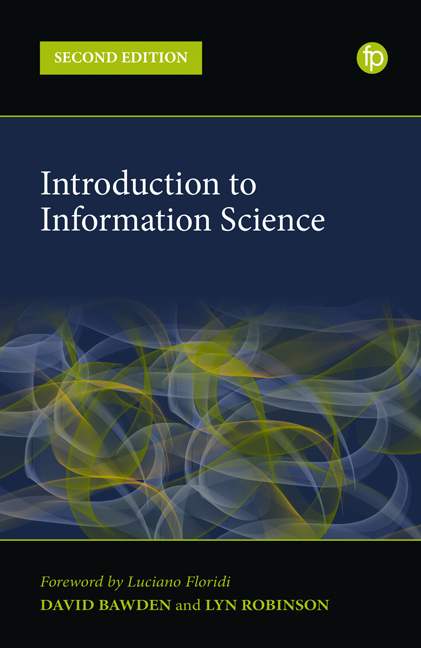Book contents
- Frontmatter
- Contents
- Figures
- Preface
- Foreword – Curators of Semantic Capital
- List of Acronyms
- 1 The Information Science Discipline
- 2 History of Information: the Story of Documents
- 3 Philosophies of Information
- 4 Paradigms, Turns and Theories in the Information Sciences
- 5 Information
- 6 Documents and Documentation
- 7 Domain Analysis
- 8 Information Organisation
- 9 Digital Technologies and Data Systems
- 10 Information Systems
- 11 Informetrics
- 12 Information Behaviour
- 13 Communicating Information: Changing Contexts
- 14 Information Management and Policy
- 15 Information Law and Ethics
- 16 Information Society
- 17 Digital (Onlife) Literacies
- 18 Research in the Information Sciences
- 19 The Future of the Information Sciences
- Additional Resources
- Index
9 - Digital Technologies and Data Systems
Published online by Cambridge University Press: 21 April 2022
- Frontmatter
- Contents
- Figures
- Preface
- Foreword – Curators of Semantic Capital
- List of Acronyms
- 1 The Information Science Discipline
- 2 History of Information: the Story of Documents
- 3 Philosophies of Information
- 4 Paradigms, Turns and Theories in the Information Sciences
- 5 Information
- 6 Documents and Documentation
- 7 Domain Analysis
- 8 Information Organisation
- 9 Digital Technologies and Data Systems
- 10 Information Systems
- 11 Informetrics
- 12 Information Behaviour
- 13 Communicating Information: Changing Contexts
- 14 Information Management and Policy
- 15 Information Law and Ethics
- 16 Information Society
- 17 Digital (Onlife) Literacies
- 18 Research in the Information Sciences
- 19 The Future of the Information Sciences
- Additional Resources
- Index
Summary
While computing technologies are young by comparison with other efforts of human ingenuity, their origins go back to many early chapters in the human quest for the understanding and realization of mechanical aids to knowledge.
Giuseppi Primiero (2020, 7)Computing is symbol processing. Any automaton capable of processing symbol structures is a computer … We may choose to call such symbol structures information, data, or knowledge, depending in the particular ‘culture’ within computer science to which we belong.
Subrata Dasgupta (2016, 121)Data science is the process by which the power of data is realised, it is how we find actionable insights from among the swathes of data that are available.
David Stuart (2020, xvi)Introduction
Technology, from the Greek techné, meaning art, skill or craft, is usually taken to mean the understanding of how to use tools, in the broadest sense of the word. The term information technology was first used in the 1950s to describe the application of mechanised documentation and then-new digital computers, and became widely used in the 1980s to describe the widerspread use of digital technology (Zorkoczy, 1982).
Information technology is usually associated with computers and networks. But, in a wider sense stemming from the original meaning of the word, the technologies of information include all the tools and machines which have been used to assist the creation and dissemination of information throughout history, as discussed in Chapter 2; from ink and paper, through printing to microforms, document reproduction and photocopying, and mechanised documentation technologies such as card indexes, punched cards, edge-notched cards, and optical coincidence cards. Krajewski (2011) examines the idea of card index files as a ‘universal paper machine’, in a sense the forerunner of the computer, between the 16th and 20th centuries.
Our focus here is on digital technologies, echoing the view expressed by Gilster (1997) that all information today is digital, has been digital or may be digital. This chapter covers the basics of digital technologies and the handling of data; the following chapter deals with information systems.
Digital technologies
We will describe these aspects only in outline; see Ince (2011) and Dasgupta (2016) for more detailed but accessible accounts, and Primiero (2020) for a more advanced summary; for accounts of the historical development of the computer, see Ceruzzi (2012) and Haigh and Ceruzzi (2021).
Information
- Type
- Chapter
- Information
- Introduction to Information Science , pp. 167 - 188Publisher: FacetPrint publication year: 2022
